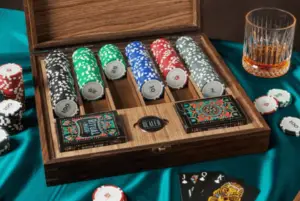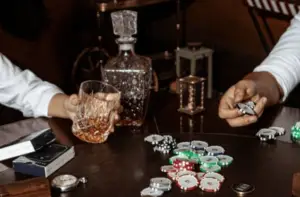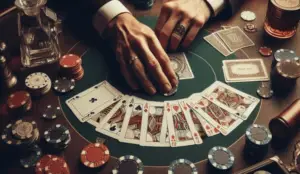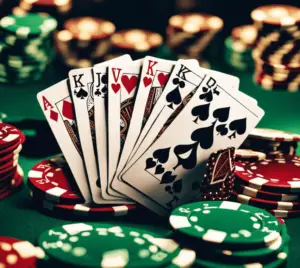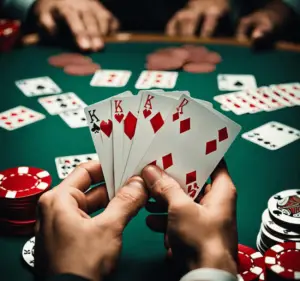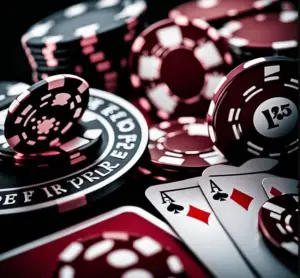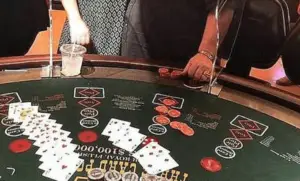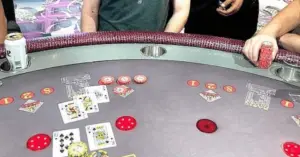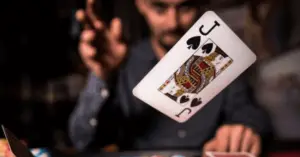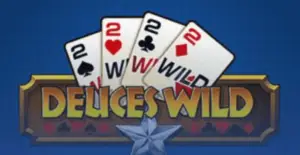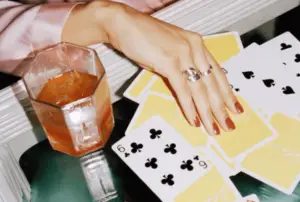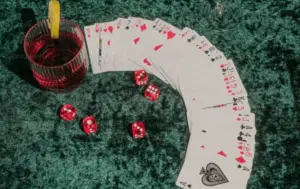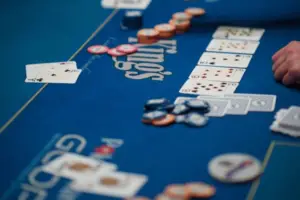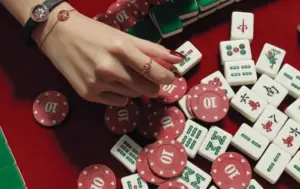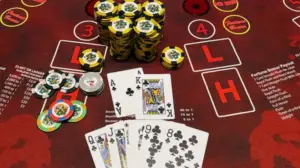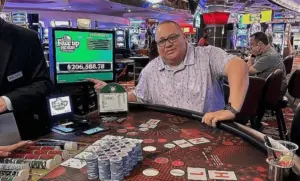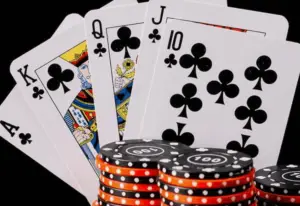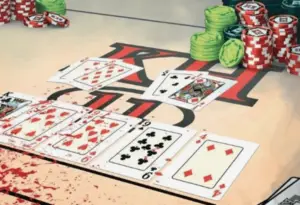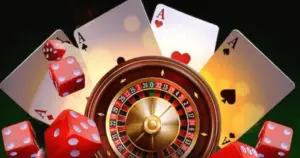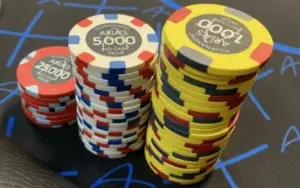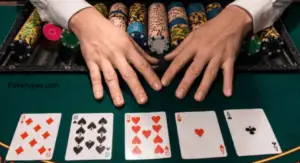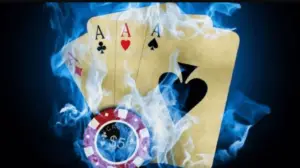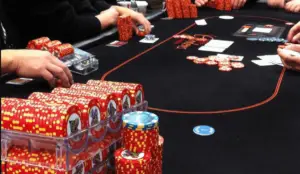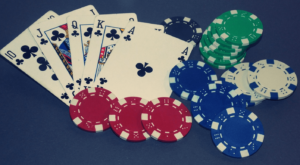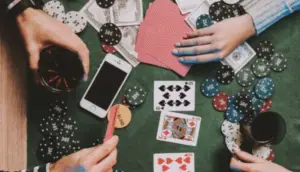A poker range represents the complete set of possible hands a player could have in any given situation. Rather than trying to guess specific cards, thinking in terms of ranges allows players to make more strategic decisions based on probability and position.
For example, when a tight player raises from Under the Gun, their range typically includes premium hands like pocket pairs (88+), strong-suited connectors, and broadway cards like AK and AQ.
This systematic approach helps players make better decisions by considering the full spectrum of possible holdings rather than randomly guessing individual hands.
Understanding ranges is particularly crucial because poker is a game of incomplete information, where making educated guesses about opponents’ possible holdings leads to more profitable decision-making.
Forms of Representing Poker Ranges
Poker ranges can be represented in 4 following forms:
1. Poker Hand Matrix
The poker hand matrix is a 13×13 grid showing all 169 possible starting hands in Texas Hold’em. This visual tool displays pocket pairs diagonally, with suited hands above and offsuit hands below the diagonal. For example, “AKs” represents suited Ace-King combinations, while “AKo” indicates offsuit Ace-King hands.
2. Percentage Form
Poker ranges can be expressed as percentages of the total possible hand combinations. For instance, if a player has an 18% VPIP (Voluntarily Put In Pot) from the middle position, this means they’re playing the top 18% of possible starting hands.
Modern tracking software like Holdem Manager and Poker Tracker commonly use this percentage-based representation to analyze player tendencies.
3. Range Combos
The total number of possible hand combinations in poker is 1,326, broken down as follows:
Pocket pairs: 6 combinations each (78 total)
Suited hands: 4 combinations each (312 total)
Offsuit hands: 12 combinations each (936 total)
For example, pocket Aces (AA) has six possible combinations:
| textA♠A♥, A♠A♦, A♠A♣, A♥A♦, A♥A♣, A♦A♣ |
4. Range Strands
Range strands use text notation to represent hand ranges concisely. Common notations include:
“22+” means all pocket pairs from deuces up
“ATs-AQs” indicates all suited Ace-Ten through Ace-Queen combinations
“JJ+” represents all pocket Jacks or better
This format is particularly useful in poker forums and strategy discussions where visual representations aren’t practical.
The notation before the hyphen shows the lowest hand in the range, while the part after indicates the highest hand.
Building and Calculating Ranges
Now we will explore how to build and calculate ranges in poker.
Factors in Range Assignment
When building poker ranges, several key factors must be considered. A player’s position, playing style, and previous actions all influence their likely holdings.
For example, a tight-aggressive player opening from Under the Gun will typically have a much stronger range (around 9% of hands) compared to the same player opening from the Button (closer to 35% of hands).
The DEAF System
The DEAF system provides a structured approach to range building:
Define: Establish the initial range based on position and action
Estimate: Calculate probable holdings based on player tendencies
Axe: Remove unlikely hands based on betting patterns
Factors: Consider additional variables like stack size and tournament stage
Common Preflop Raising Ranges
Standard opening ranges vary by position:
1. Early Position (UTG):
- 9% range including 66+, AJs+, KQs, AJo+, KQo
2. Middle Position:
- 15% range adding 22-55, ATs+, KJs+, and suited connectors
3. Late Position (CO/BTN):
- 20-25% range incorporating more suited connectors and broadway hands
Standard Preflop Calling Ranges
Calling ranges depend heavily on position and opponent’s range:
1. Big Blind vs Button:
- 25.8% calling range
- Includes small pairs, suited connectors, and Broadway hands
2. Big Blind vs Small Blind:
- 35% calling range
- Widest defending range due to positional advantage
3. Early Position vs Early Position:
- 8% calling range
- Limited to strong hands like JJ-22, AQs-AJs, KQs
The key to effective range building is understanding that ranges narrow as the hand progresses.
For example, if a tight player shows aggression on multiple streets, their range becomes increasingly polarized toward very strong hands or bluffs. This dynamic nature of ranges makes poker a complex game of constant range adjustment and refinement.
Range Dynamics
Multiway Pot Considerations
In multiway pots, ranges naturally tighten as more players enter the hand. When facing multiple opponents, your value betting range should be significantly stronger than in heads-up situations.
For example, in a three-way pot, the top pair with a weak kicker becomes much more vulnerable, and you should typically narrow your continuing range to include mainly strong pairs and better.
Position-Based Adjustments
Your position at the table dramatically affects range construction. A UTG player’s raising range typically includes only 10% of hands, while a Button range might include up to 40% of holdings. For instance:
- UTG: 88+, ATs+, KQs
- Button: 22+, A2s+, K8s+, Q8s+
Opponent-Based Adjustments
Different player types require different range adjustments:
Tight Players:
- Narrow their ranges significantly in early positions
- Rarely bluff on multiple streets
- Usually, they have exactly what they represent
Loose Players:
- Play a wider range from all positions
- More likely to continue with marginal holdings
- Often show up with unexpected combinations
When facing a tight-aggressive player, you can safely fold marginal holdings to their aggression, while against loose-passive opponents, you can profitably continue with weaker hands, knowing they’re playing a wider range.
Postflop Range Considerations
Carrying Preflop Ranges to Postflop
When moving from pre-flop to post-flop play, ranges are naturally narrow based on board texture. A tight UTG range of 10% becomes even tighter on a low board like 732 while maintaining more strength on Broadway-heavy boards. For example, a UTG raiser’s range hits an AKQ flop much harder than a 567 flop.
Board Texture Analysis
Board textures significantly impact range advantage. On wet boards(connected, suited cards), drawing hands gain significant equity, while dry boards favor strong-made hands. For instance, holding KJon on a K-4-T board is much stronger in a multiway pot than on a K-Q-J board.
Pot Odds and Implied Odds
In multiway pots, both pot odds and implied odds increase dramatically. Your equity decreases as more players enter the pot – for example, AK drops from 67% equity heads-up to just 41% against three random hands. This means you should:
Play more drawing hands with good implied odds
Avoid marginally made hands like weak top pair
Focus on hands that can make the nuts
C-betting in Multiway Pots
Continuation betting requires significant adjustments in multiway pots:
- Use smaller bet sizes (typically 1/3 to 1/2 pot)
- Bet primarily for value with strong hands
- Reduce bluffing frequency significantly
- Choose high-equity bluffs like flush draws and open-ended straight draws
For example, when c-betting into three players, your success rate for bluffs multiplies – if each player folds 60% of the time, your overall success rate is only 21.6% (0.6 x 0.6 x 0.6).
GTO vs. Exploitative Ranges
Game Theory Optimal ranges represent mathematically balanced distributions of hands that are theoretically unexploitable.
These ranges maintain a perfect equilibrium between value bets and bluffs, making it impossible for opponents to gain an edge through adjustments.
For example, on the river, a GTO strategy might bluff exactly 33% of the time with the right hands to make opponents indifferent between calling and folding.
Limitations of Human Implementation
While GTO play provides a solid theoretical framework, perfectly executing these strategies is practically impossible for humans. Even the best players can only approximate GTO play, as it requires:
- Maintaining exact betting frequencies
- Perfect hand selection for bluffs
- Consistent sizing across all situations
Benefits of Exploitative Play
In smaller-stakes games, exploitative play often yields better results than strict GTO adherence. Key advantages include:
- Targeting specific player tendencies (like over-folding to 3-bets)
- Adjusting ranges based on opponent mistakes
- Simplified decision-making in common situations
For instance, against players who fold too often, you can profitably increase your bluffing frequency well above GTO recommendations.
In live poker, players often fold to 3-bets much less frequently than optimal, making it profitable to 3-bet more value hands and fewer bluffs than GTO suggests.
Range Reading and Exploitation
Let’s examine how to exploit the opponent’s range for our benefit.
Process of Narrowing Opponent’s Range
When narrowing an opponent’s range, start by analyzing their preflop actions and position. A tight player opening from UTG typically has a narrow range of premium hands and strong Broadway cards.
As the hand progresses, use board texture and betting patterns to further narrow their holdings. For example, if they continue betting on a K72 rainbow board, their range likely contains strong King-high hands and overpairs.
Formulating Exploitative Strategies
Exploitative play involves adjusting your strategy based on opponent tendencies. Against players who fold too often, increase your bluffing frequency well above the standard 33% GTO ratio.When facing calling stations, reduce bluffs and focus on value betting with strong hands.
Balancing vs. Exploiting
While balanced ranges protect against skilled opponents, most lower-stakes games benefit more from exploitative adjustments
.Key considerations include:
Using unbalanced ranges against weak players who don’t adjust
Maintaining some balance in multiway pots
Protecting value hands with selective bluffs
For instance, against opponents who over-fold to continuation bets, you can profitably c-bet almost any two cards, regardless of perfect range balance.
Practical Application of Ranges
Now let’s consider the practical application of ranges and see how they can be used.
Example Hand Analysis
Consider a $1/$2 NLHE hand where you hold 77 on the button against a UTG raiser. A typical UTG range includes 88+, ATs+, and AQo+. After they bet half-pot on a K-7-2 rainbow flop, their range narrows to primarily pocket pairs and King-high hands.
Postflop Decision-Making
Your decisions should reflect how your hand performs against the opponent’s likely holdings. On the K-7-2board:
- You beat their underpairs (88-99)
- You lose to their overpairs (TT+)
- You crush their King-high hands
This analysis suggests acallis appropriate, as you have good equity against their overall range.
Adjusting Ranges Based on Tendencies
Different player types require different range adjustments:
Tight-Aggressive Players:
- Opening range: 12% of hands
- Heavy emphasis on premium pairs
- Rarely continue without strong pairs post-flop
Loose-Passive Players:
- Opening range: 35% of hands
- Include many suited connectors
- Continue with weaker pairs post-flop
For example, against a loose player who rarely folds to continuation bets, you should tighten your bluffing range and expand your value betting range significantly.
How to Improve Range Reading Skills?
I suggest you follow the following steps if you want to enhance your range of reading abilities:
Practice Techniques
To improve range reading, start by studying hand histories without seeing opponent hole cards. Begin with their preflop range and narrow it down based on each action.
For example, when reviewing a hand where a tight player opens from UTG and continues betting on an A-K-7 board, practice assigning them a realistic range of premium pairs and strong Ace-high hands.
Resources for Further Study
Several tools can enhance your range of study:
- Poker tracking software (like Holdem Manager or PokerTracker)
- Range analysis tools like Equilab
- Online training sites with range calculators
Importance of Off-Table Work
A dedicated off-table study is crucial for range reading improvement. Spend 4-5 hours analyzing your own ranges by:
- Documenting your opening ranges from each position
- Understanding your continuation betting patterns
- Comparing your ranges to GTO solutions
This work helps you understand both your own tendencies and those of similar players. When you know that you c-bet65% of the time on Ace-high boards, you can better recognize when opponents are deviating from standard patterns.
Conclusion
Mastering poker ranges transforms your game from guessing individual hands to making strategic decisions based on complete hand distributions.
By understanding that a tight player opening from UTG typically has a 10% range including TT+ and AQs+, you can make better decisions across all streets.
While GTO ranges provide a theoretical foundation, most players benefit more from exploitative adjustments based on opponent tendencies.
Regular practice with range tools and dedicated study of hand histories helps develop this crucial skill, leading to more profitable decision-making at the tables.


